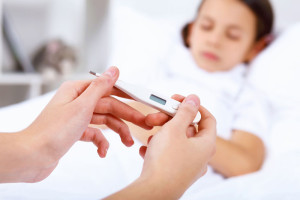Febrile seizures are found mostly in children as children have a lower seizure threshold than adults. Most of the febrile seizures are benign meaning that they were due to a high fever, which came on suddenly in a child between 3 months and 5 years.
In that age group about 4% of children will seizure with a high fever as the seizure threshold is lower than in older children and in adults. It is important to treat fevers right away with acetaminophen (brand name: Tylenol) and to give cool baths or ice packs to reduce the core temperature.
It is necessary for the physician to rule out an intracranial infection (like meningitis or encephalitis).
Benign febrile seizures are brief, generalized and of a tonic-clonic nature (thanks to www.nlm.nih.gov for this image). They are solitary meaning that they only occur once with a fever episode. In contrast, complex febrile seizures last either more than 15 minutes, are of a focal nature, or they reoccur more than two times in a 24 hour interval.
Complex febrile seizures have a higher incidence of developing into epilepsy later in life.
Other negative predictors are a congenital neurological problem, an age of less than 1 year with the first febrile convulsion and a history of epilepsy in the family.
Treatment
Benign febrile seizures are usually not treated as the side-effect of the anti-epileptic drugs are worse than the risk of the febrile convulsion. With complex febrile seizures a maintenance of phenobarbital is given for a period of time until the child has outgrown the danger zone. However, the pediatrician or child neurologist has to balance the side-effect of sedation and negative effect on the learning capacity of the child with the benefit of the medication in terms of controlling the seizures.
References:
1. F Zara et al. Am J Hum Gen 2000 May 66(5): 1552-1557.
2. S Yeung et al. Europ J Paediatr Neurol 2000; 4(1): 31-33.
3. LS Leung et al. Neurosci Biobehav Rev 2000 Sep 24(7): 763-775.
4. DJ Yen et al. Epilepsia 2000 Sep 41(9) 1162-1166.
5. E Starreveld et al. Can Fam Physician 2000 Sep 46: 1817-1823.
6. The Merck Manual, 7th edition, by M. H. Beers et al., Whitehouse Station, N.J., 1999. Chapter 172.
7. The Merck Manual, 7th edition, by M. H. Beers et al., Whitehouse Station, N.J., 1999. Chapter 271, p.2415.
8. Ferri: Ferri’s Clinical Advisor: Instant Diagnosis and Treatment, 2004 ed., Copyright © 2004 Mosby, Inc.
9. Rakel: Conn’s Current Therapy 2004, 56th ed., Copyright © 2004 Elsevier







